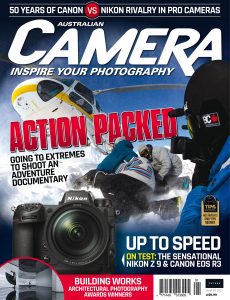
Australian Camera – January-February 2022
English | 86 pages | pdf | 67.93 MB
The Tradition Continues Australian Camera Magazine January-February 2022 Issue
AS HAS BEEN THE CASE SINCE THE EARLY 1970s, Canon and Nikon have again shadowed each other pretty closely with their next generation of pro-level interchangeable lens cameras. It’s worked out pretty neatly that we have both on test in this magazine issue, and it again illustrates the different philosophical approaches of each brand in the execution of a professional camera. While the EOS R3 and Z 9 have plenty in common, they’re also quite different in a number of key areas… and this has been the case over the decades of the two going head-to-head in the pro category.
Of course, the big deal this time around is that we’re seeing the first full-frame mirror less pro cameras from the traditional rivals, so there’s perhaps a bit more riding on their respective designs given all the potential buyers are facing big changes in terms of a full system rather than just a couple of new bodies. However, even though there is the possibility of switching camps, I don’t really expect many will… at least not those buying their own gear. Canon and Nikon users now tend to be rusted on, but in the early days it was definitely more of a contest to make converts. You’d have to say that Canon has had the better of it, probably since it introduced the original EOS-1 in 1989 to do battle with Nikon’s F4, which was launched a year earlier. These were the first pro-level autofocus 35mm SLRs (the earlier Nikon F3AF was only a toe-in-the-water exercise) and here the fundamental technical difference was to prove significant over the coming years – Canon opting for lens-based AF motors, Nikon going for an in-body drive. It meant taking the very courageous decision to change lens mount (to a fully electronic fitting), but consequently Canon gained an important edge in AF performance and built on it relentlessly with the subsequent EOS-1N and EOS-1V models.
Despite the excellence of the F5 – arguably the best 35mm SLR Nikon ever built – and the arrival of motorised AF-S Nikkor lenses, Canon made enough converts to put it on top in the pro market, creating a solid foundation for the transition to digital with the EOS-1D in late 2001. With the EOS- 1Ds – launched less than a year later – Canon really got into its stride with its own full-frame CMOS sensor (when CCDs still dominated) with a then massive 11MP resolution. Again, a fundamental technical difference made its mark, and Canon’s decision to make its own sensors definitely put it more in charge of its own destiny. It took until 2007 and the much-lauded D3 for Nikon to catch up and, anecdotally at least, make a few converts of its own. From then on things have been pretty evenly matched through to the current EOS-1D X Mark III and D6 – once again similar but different.
For starters, the Canon is much more of a hybrid still/video camera than the more photo-orientated Nikon. Now, Canon has said there will be no more pro-level DSLRs and it’s safe to assume it will be the same over at Nikon. And, in the full-frame mirror less sector, there’s another and very serious rival, with Sony appearing to have closely followed the Canon playbook in the development of its FEmount system. Of course, Panasonic, Fujifi lm and Olympus (a.k.a. OM System) are also targeting pro-level users with the OM-D E-M1X, arguably the closest current competitor to the EOS R3 and Z 9… at least in its design philosophy.
So are the days of the traditional Canonversus- Nikon pro camera rivalry over? I, for one, don’t think so. Despite Sony’s best efforts (which are undoubtedly impressive), the heritage and history of both brands still mean something in the pro camera market, and the R3 and Z 9 illustrate that both are also capable of being more than competitive in this new era of mirror less
configuration and hybrid still/video designs. And both are going nuts with new mirrorless lenses – as illustrated by the RF 70-200mm f/4.0 and Nikkor
Z 100-400mm f/4.5-5.6 zooms that came with our respective test cameras – so this really is no longer an issue compared to the longer-established systems.
The really good news is that these cameras still have their essences rooted in solidly photographic backgrounds and these influences are still evident on a number of levels, from conception to application. We’ve come a very long way from the original Nikon F (1959) and Canon F-1 (1971), but the shared philosophy of creating the most capable and reliable tools possible for photographers exacting demands remains the same
Paul Burrows, Editor
Download from: